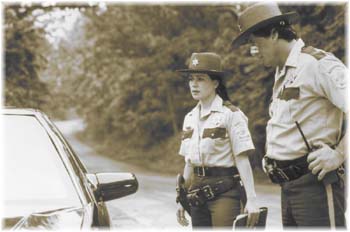![[Metroactive Movies]](http://metroactive.com/movies/gifs/movies468.gif)
![[Metroactive Movies]](http://metroactive.com/movies/gifs/movies468.gif)
[ Movies Index | Metro | Metroactive Central | Archives ]
NYPD Beef
The pounds make the man in Stallone's predictable 'Cop Land'
FREDDY HEFLIN in Cop Land is a different role for Sylvester Stallone, but it isn't all that different. The much-publicized 40 pounds Stallone gained have gone mostly to his neck; when he moves his massive head, he looks like a steer sniffing the wind. Heflin is the sheriff of Garrison, N.J., a small town right underneath the Palisades, across the river from Manhattan. Since there isn't much work for him to do, Heflin spends his time staring mournfully across the Hudson at the city where he could never get a break--and when Stallone stares mournfully, you can hear the bells tolling.
The crime problem in his town is nonexistent, since it's an NYPD bedroom community. The police commute across the bridge in the morning and come back at night to hang out at the 4 Aces bar, Garrison's only tavern. Heflin would have joined the NYPD if it weren't for his bad hearing: he went deaf in one ear rescuing a woman from drowning. Mindful of Heflin's failure to be one of them, the cops hanging out at the 4 Aces tolerate him. None of them takes the sheriff seriously (and they seem to regard him as a mug for saving a woman's life). Then the trouble starts. A heroic officer apparently jumps off the George Washington Bridge; Moe (Robert De Niro), a member of the NYPD Internal Affairs committee, turns up in Heflin's office; and Heflin's chance for respect finally comes.
Director James Mangold repeats many of the same visual motifs he used in his debut film, Heavy. Like Heavy, Cop Land is shot in a dozing, decaying river town during overcast weather. Most of what makes the film interesting takes place behind the actors, rather than because of them. The formidable cast seems to be marking time, waiting for something interesting to engage their skills. De Niro, Harvey Keitel, Ray Liotta, Michael Rappaport, Janeane Garofolo and Cathy Moriarty (as the old-timey town floozy, named "Rose," and equipped with a white lap dog, yet) all have their moments, but the film's B-movie inevitability keeps it from being anything more than just a familiar, sometimes satisfying diversion.
Mangold's script is obvious; it gives up chunks of back-story in barroom speeches and flashbacks. And Heflin may be the underdog, but he's not down very far. When it comes time for him to settle things, we can tell that Cop Land will have the preferred ending of a Sylvester Stallone movie: our easygoing hero will avenge the slights against him with a shotgun. If Stallone has improved, it's only in degree. Now, he uses just the heavy droop of his eyelashes to present sorrow; once upon a time, he would have hung his whole steam-shovel jaw. He's making the effort to improve his work by starring in a smaller-than-life movie, but despite the credibly small scale, Cop Land is just as fake as all of Stallone's terrible larger-than-life movies.
[ Metro | Metroactive Central | Archives ]
Copyright © Metro Publishing Inc. Maintained by Boulevards New Media.

It Only Hurts When He Breathes: Nostril-bandaged Sylvester Stallone and Janeane Garofalo dish out a speeding ticket in 'Cop Land.'
Cop Land (R; 100 min.), directed and written by James Mangold, photographed by Eric Alan Edwards and starring Sylvester Stallone, Harvey Keitel and Robert De Niro.
From the August 21-27, 1997 issue of Metro.